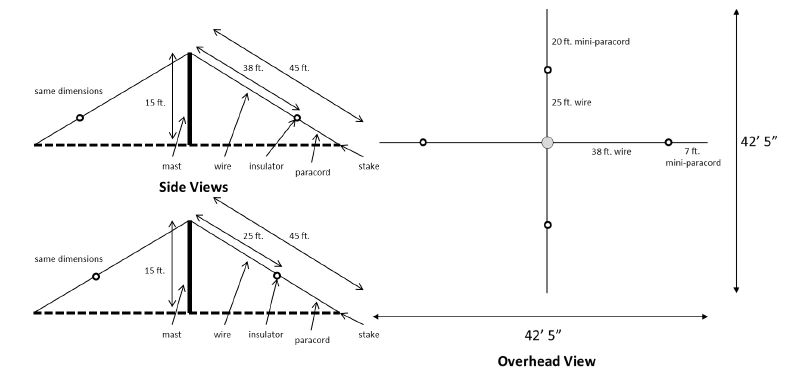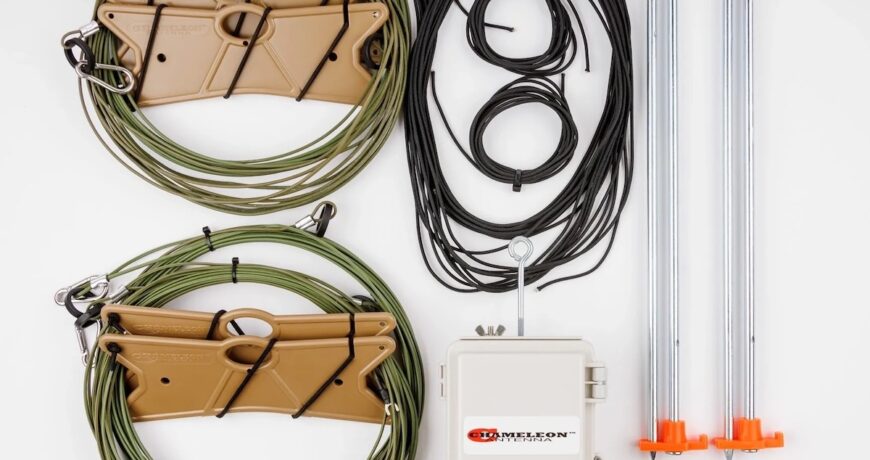The NVIS Antenna – Characteristics and Benefits Leave a comment
The Near Vertical Incidence Skywave (NVIS) antenna stands out as a versatile and remarkable innovation that has revolutionised short to medium-distance HF communication, especially during challenging conditions such as in remote areas or in disaster-stricken regions. Possessing distinct characteristics and offering a plethora of benefits, this antenna has emerged as a crucial tool for maintaining connectivity even when traditional means falter. Chameleon Antenna™ has taken the world’s most popular NVIS antenna, the U.S. Army’s AS-2259/GR, and made it better. But first, let’s investigate the characteristics of NVIS Antennas:
- Vertical Incidence Propagation: The defining feature of the NVIS antenna is its capacity to utilize vertically incident radio waves. These waves are transmitted upwards and are reflected back to Earth’s surface at a steep angle, typically between 60 to 90 degrees. This mode of propagation allows signals to cover relatively short distances (typically 0 to 650 km) but ensures consistent coverage in areas that would otherwise be radio shadows, such as valleys or urban canyons.
- High Elevation Angles: Unlike other antennas that rely on lower elevation angles and higher power for longer-distance propagation, NVIS antennas work efficiently at 2-10 MHz and higher elevation angles. This characteristic results in a skywave that envelops the immediate vicinity, making these antennas an ideal choice for tactical and emergency communication purposes.
- Omnidirectional Radiation Pattern: NVIS antennas exhibit an omnidirectional radiation pattern, ensuring that signals are transmitted and received uniformly in all directions within their designated coverage area. This characteristic eliminates the need for precise alignment and orientation, simplifying deployment and operation.
- Resistance to Fading: NVIS antennas are notably resistant to fading, a phenomenon that often plagues long-distance communication. The vertical propagation mode minimizes signal degradation caused by factors like atmospheric conditions, terrain, and multipath interference, providing a stable and reliable link even in challenging environments.
Benefits of NVIS Antennas:
- Effective Communication in Challenging Terrain: One of the primary benefits of NVIS antennas is their ability to establish communication links in rugged terrains, valleys, and areas with obstructed line of sight. Traditional line-of-sight antennas struggle in such scenarios, making the NVIS indispensable for military operations, disaster response, and remote communication.
- Resilience in Disaster Situations: In the aftermath of natural disasters, traditional communication infrastructure often crumbles. NVIS antennas can be swiftly deployed to establish localized communication networks, allowing relief agencies, first responders, and affected communities to coordinate efforts and provide vital assistance.
- Reduced Interference and Improved Security: The high-angle propagation of NVIS signals reduces the chances of interception or eavesdropping compared to more conventional antennas with a lower elevation angle. This characteristic enhances the security of communication, making NVIS antennas a preferred choice for military, law enforcement, and intelligence agencies.
- Cost-Efficiency and Ease of Deployment: NVIS antennas are relatively simple, requiring minimal technical expertise and equipment. Their versatility in terms of frequency range and compatibility with various transceivers further adds to their cost-effectiveness. This ease of deployment makes them an attractive option for temporary communication setups and scenarios where time is of the essence.
In the evolving landscape of communication technology, the NVIS antenna’s unique characteristics enable effective communication in challenging conditions, ensuring that critical information continues to flow when it’s needed the most. Whether in disaster zones, military operations, or your weekly 80 meter ham-radio net, the this antenna illuminates the night and keeps you connected with the world.

The Chameleon NVIS is a specialised antenna designed primarily for NVIS propagation and for use by serious Emergency Communication (EMCOMM) operators. The typical use case for the Chameleon NVIS would be for use inside a disaster area where communications with emergency aid providers, who are located just outside the affected area, is required. The Chameleon NVIS will operate from 1.8 – 54.0 MHz (including 160m – 6m Amateur Service bands) without any adjustment when used with an antenna tuner. This antenna requires one center support, approximately 15 feet in height, and is selfguying. Setup is quickly and easily accomplished in the field by two personnel. Although primarily designed for NVIS propagation, this antenna will also provide satisfactory medium range portable HF communication, particularly on higher frequencies.


